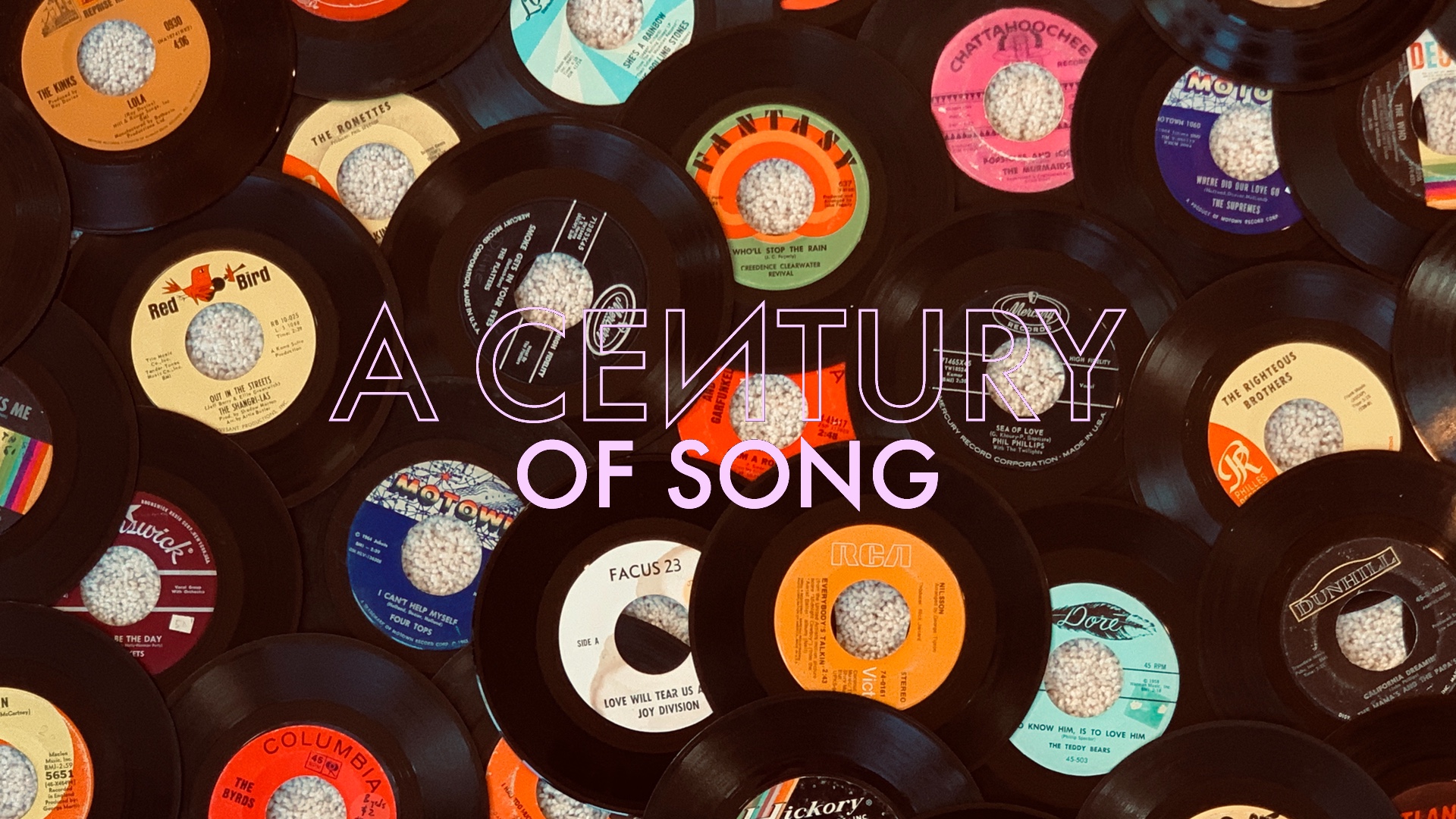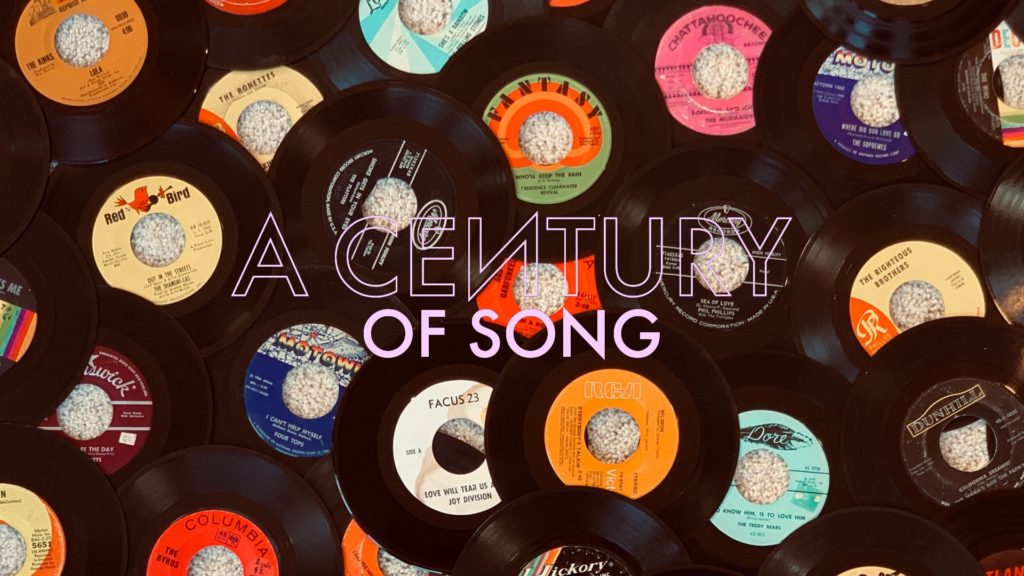
A Century of Song is an attempt to summarize 100 years of popular music through 1000 carefully chosen tracks. Included within this list are landmark singles, stellar album cuts, huge hits, hidden gems, and more than a few personal favorites. Read the introduction for the project here, and enjoy the embedded videos and Spotify playlist.
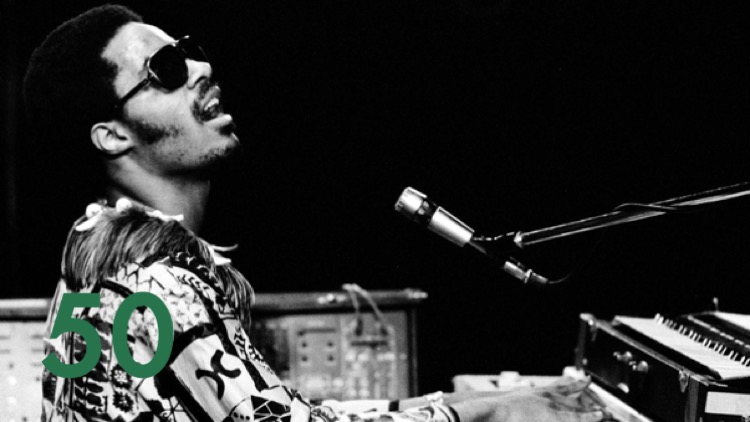

Though Stevie Wonder undeniably hit his peak as an album artist with his remarkable run of mid-seventies classics, he was – for my money – never better than on this fantastic 1970 single. Bursting at the seams with energy and joyous hooks, “Signed, Sealed, Delivered I’m Yours” is an irresistible track from one of America’s greatest musical minds.
Opening with a sitar-like guitar hook, “Signed, Sealed, Delivered” hinted at the broadening influences that would inform the stylistic diversity of Wonder’s mid-decade peak. From there, it’s all stomping rhythm and great vocal performances from Wonder, and backing vocalists Lynda Tucker Laurence, Venetta Fields, and Syreeta Wright – the last of whom had helped Wonder with the song’s composition.
“Signed, Sealed, Delivered” marked Stevie Wonder’s first appearance as the producer of one of his own songs. Barely out of his teens at the time, the single’s critical and commercial success – it peaked at #3 on the U.S. pop charts – would further bolster his confidence, and lead Wonder to produce the immortal stretch of albums from 1972’s Music of My Mind to 1976’s Songs in the Key of Life.
As outstanding as that future run of albums was, with “Signed, Sealed, Delivered,” Wonder found a perfect balance between the promise and raw excitement of his early work, and the ambition and perfectionism of his later masterpieces. Few artists in the history of pop music have a more impressive resume than Stevie Wonder, but this is, unquestionably, my favorite moment in his catalog.
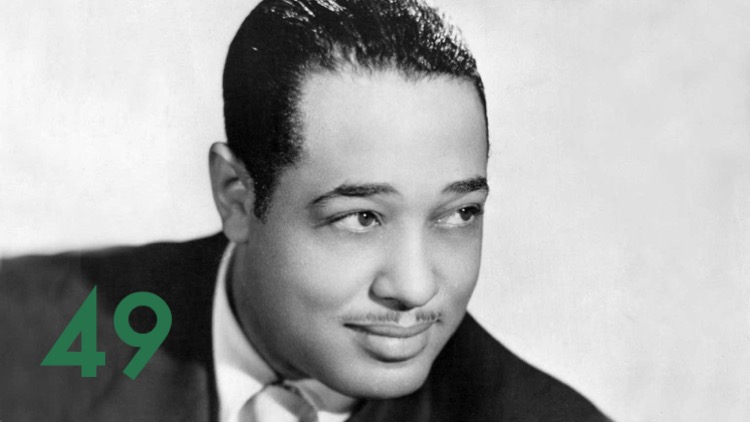

Few, if any, songs loom larger in the legacy of Duke Ellington than “Mood Indigo.” Co-written with clarinetist Barney Bigard in 1930, the dreamy ballad represented Ellington at his most subdued and wistful – a feeling expertly captured in the song’s arrangement and perfectly fitting title.
While Ellington would record “Mood Indigo” dozens of times over the course of his illustrious career, the version that he released as a single for Victor in early 1931 is particularly notable. Credited to Ellington and His Cotton Club Orchestra, that recording exemplified the track’s elegant construction, highlighting Duke’s unique arrangement of the horn section without the more bombastic elements of later incarnations of the song.
In time, “Mood Indigo” would become a jazz standard, surpassing even the greatest masterpieces in Ellington’s oeuvre. It would remain a staple of concert performances for decades, and Ellington would record the track alongside other jazz icons, such as Louis Armstrong, Ella Fitzgerald, and Coleman Hawkins. Additionally, luminaries such as Charles Mingus, Nina Simone, Thelonious Monk, Sidney Bechet, and Frank Sinatra would record their own takes on the song.
Despite these numerous reinventions, collaborations, and tributes, the sublime beauty of Ellington’s 1931 single version would never be surpassed. It stands as three utterly perfect minutes of music and mood – a personal peak from a man who may just be the greatest American composer of all-time.
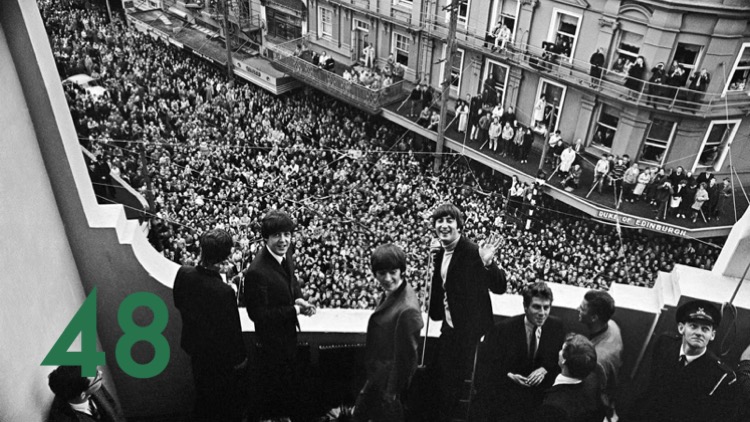

Beatlemania was already in full flight in Britain by the time The Beatles released “I Want to Hold Your Hand” in late 1963. Prompted by the runaway success of the band’s previous single, “She Loves You” (#101), advanced sales of “I Want to Hold Your Hand” surpassed a million before anyone outside of The Beatles’ camp ever heard a note of it. When it finally arrived, the song would dramatically expand the group’s profile outside of their home country.
Maintaining the giddy excitement of “She Loves You,” “I Want to Hold Your Hand” is similarly constructed, but its hook was arguably even more irresistible than the former track’s indelible “yeah, yeah, yeah” chorus. That hook was the leaping, harmonized vocal shout of “HAAAAAND” that transitions each verse into the song’s unforgettable chorus. Driven home by a spirited instrumental performance, the track’s commercial success was all but guaranteed.
On December 17, 1963, Washington, D.C. radio deejay Carroll James played “I Want to Hold Your Hand” on American radio for the first time. Prompted by a letter from fifteen-year-old Marsha Albert, James had secured a copy of the single from a stewardess from the B.O.A.C., three weeks before it was due to be released in the United States. The track became an immediate sensation amongst area teens – still very much reeling from the death of President John F. Kennedy just four weeks prior – prompting The Beatles’ American label, Capitol Records, to expedite the arrival of “I Want to Hold Your Hand” in U.S. record shops.
By the first of February, “I Want to Hold Your Hand” was the number one song in America. A week later, The Beatles arrived in the U.S. for the first time. The talents that this group of four Liverpudlians had first honed on the rough streets of Hamburg had eventually made them stars in their native UK, but The Beatles were no longer merely a British band. Now they belonged to the world.


Jesus died for somebody’s sins but not mine
Meltin’ in a pot of thieves
Wild card up my sleeve
Thick heart of stone
My sins my own
They belong to me, me
For those who didn’t find the opening lines to the first song on Patti Smith’s debut album to be too heretical, perhaps it was the iconoclastic teardown of another time-tested institution – Them’s 1964 single “Gloria” (#402) – that got under their skin. Either way, it could be argued that no artist has ever introduced themselves to the world with a more brazen song than punk’s poet laureate.
By 1975, Patti Smith had dabbled in so many different fields – poetry, prose, rock criticism, performance art, photography, acting, painting – that being a foundational figure on the nascent New York punk scene was merely one bullet point on a particularly impressive resume. Her debut album, Horses was no act of musical dabbling, but instead was a full-fledged masterwork that merged the worlds of punk and serious art in a manner that none of her contemporaries could rival.
While every one of its forty-three minutes seethes with the power of Smith’s poetry and her band’s whirling energy, Horses is never more commanding, confrontational, or compelling than on its magnificent opening track. Following Smith’s attention-grabbing introduction, her group – Lenny Kaye (guitar), Richard Sohl (piano), Ivan Král (bass), and Jay Dee Daugherty (drums) – gradually build up the intensity behind her, their fiery performance made all the more immediate by John Cale’s spartan production.
By the track’s mid-point, the band has reached full force, launching Smith into a visceral re-contextualization of the garage rock classic. As it hurtles over a false stop and into an extended fade out, she stands over the smoldering wreckage of Van Morrison’s song, having blown it out of the water in every way possible.
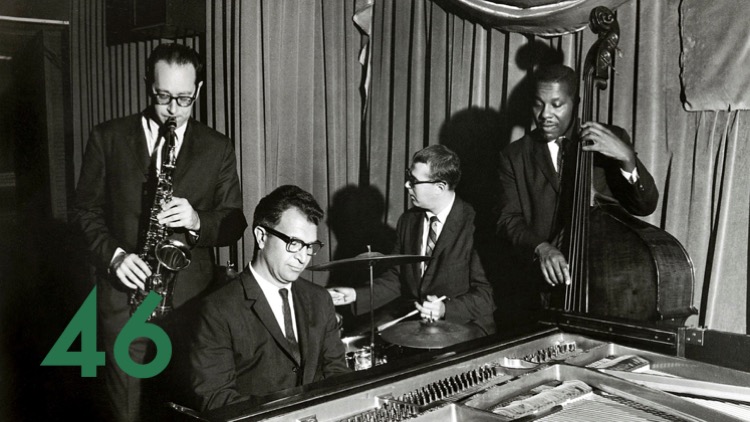

The centerpiece to one of the most commercially successful jazz albums of all-time, “Take Five” was also the first jazz single to – like its parent album – sell over a million copies. However, despite the track’s enduring appeal to generations of jazz novices and aficionados, it featured a somewhat bold innovation with its atypical time signature.
For his 1959 LP, Time Out, Dave Brubeck aimed to create a full album based on experiments with unconventional rhythms – inspired by recent a State Department-sponsored tour of Europe and Asia. It was actually his group’s saxophonist, Paul Desmond, who would compose “Take Five,” built around the 5/4 time signature hinted at in the song’s title.
It’s Desmond’s smooth alto that soars over “Take Five,” but his melodic work is equaled by the rhythmic groove established by his bandmates: Brubeck (piano), Eugene Wright (bass), and Joe Morello (drums). Together, they created a piece that was just as fitting on the dance floor, cocktail parties, or AM pop radio – where it landed comfortably within the top forty, nearly two years after its initial release.
The smooth rhythm, melodic warmth, and memorable hooks of “Take Five” would give it a rarified ubiquity for a jazz composition. Its pop culture references are too many to summarize here, but removed from any context, it remains a truly singular piece. Precious few American recordings are more iconic than “Take Five,” and even fewer are better.
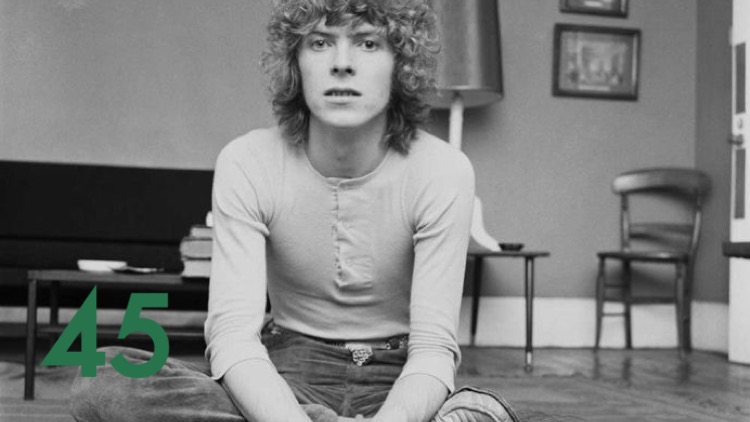

To call David Bowie “chameleonic” would undersell the penchant for radical reinvention that helped him sustain artistic relevance for nearly half a century. His first great musical reinvention came out of necessity. After the thud-like landing of his 1967 self-titled debut album, Bowie adopted a folkier, singer-songwriter style on his second (also self-titled) LP.
That record’s clear highlight was a track that pushed Bowie beyond the relatively understated arrangements of the surrounding songs. An alluring narrative of considerable melodic quality, “Space Oddity” would be adorned with the album’s most lush musical embellishments – befitting of the song’s epic inspiration and timely, topical nature.
Considered to be something of a novelty by his record label, Philips, “Space Oddity” found Bowie’s story of Major Tom adorned by trippy effects and symphonic elements – much of which were provided by Rick Wakeman’s Mellotron work. These elements helped to magnify the song’s surrealistic qualities, and further connected it to the cinematic grandeur of Stanley Kubrick’s 1968 masterpiece 2001: A Space Odyssey, which had been a clear inspiration to Bowie.
In a telling display of the label’s view of the song as one of fleeting value, Philips would release “Space Oddity” to coincide with the launching of the Apollo 11 mission. Nine days after it was released – and only a month to the day after it had been recorded – Neil Armstrong stepped foot on the surface of the Moon. Its timeliness would make the song a top ten hit in several countries, though Bowie would struggle to repeat its success over the next few years.
In time, Bowie would become an icon. For all the brilliant moments that followed, few songs in his lustrous catalog would ever quite match the charm of the track that first introduced his talents to the wider world. Upon his death in 2016, the song – and the plight of its hero – would serve as something of an epitaph for a man whose life’s work seemed to continually defy the limits of our terrestrial existence.
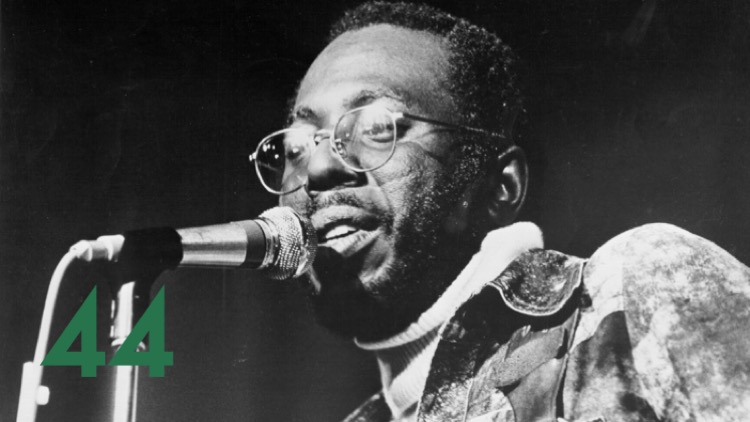

It was a bit tough choosing between the two towering highlights of Curtis Mayfield’s 1970 solo debut, but I ultimately came down on the side of optimism, placing “Move On Up” a bit higher than “(Don’ Worry) If There’s a Hell Below We’re All Gonna Go” (#70). The centerpiece of one of the greatest records of its time, “Move On Up” is a celebratory blast of funk from a master at the peak of his craft.
Stepping away from The Impressions, Mayfield made a career re-defining statement with Curtis. Something of a State of the Union address for Black America, the record balanced Mayfield’s sharp eye for cutting detail with the idealism of previous Impressions highlights, such as “Keep On Pushing,” “We’re a Winner,” and “People Get Ready” (#96). It was the latter impulse that shone through most clearly on “Move On Up.”
Buoyed by its vibrant brass hook, polyrhythmic percussion, and catchy bass line, “Move On Up” would have been a soul classic had it remained an instrumental, but paired with Mayfield’s welcoming falsetto vocals, the track reached transcendence. Shockingly, the single edit – cut down from the nearly nine-minute album version – failed to chart in the United States, despite hitting the top twenty in the UK.
Regardless of its underwhelming commercial performance, “Move On Up” now stands as one of the most iconic soul recordings of all-time. Given a second life after being sampled on Kanye West’s 2006 hit, “Touch the Sky,” the track’s unforgettable hook continues to resonate in a radiant fashion, over a half century after its initial appearance.
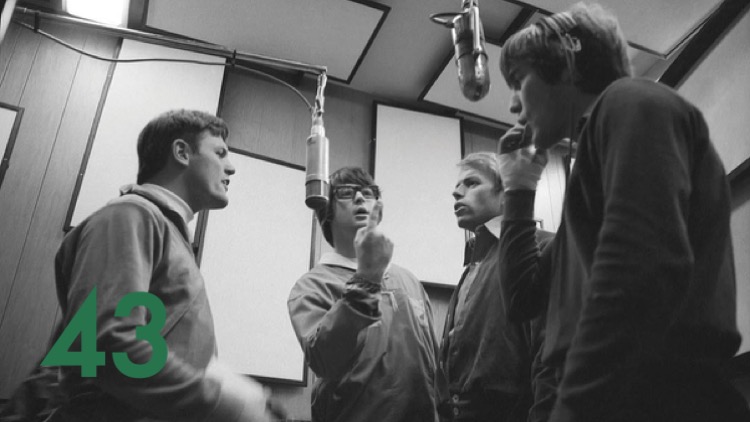

I have to be careful not to think about this one too much, lest I convince myself that I have it placed too low. The perfect introduction to the closest thing to a flawless album, “Wouldn’t It Be Nice” is a wonderful, compact summation of everything that makes Brian Wilson’s masterpiece a truly singular work within the history of popular music.
I first heard Pet Sounds in early 1999, during my first college winter break. As I’ve mentioned elsewhere, I had been prompted to buy it because of numerous comparisons to R.E.M.’s recently released album, Up. Still, despite my knowledge that it had been a critical influence on a lot of other music that I loved, I considered this purchase to be something of a guilty pleasure. It would take approximately thirty-five seconds for me to change my mind.
While “Wouldn’t It Be Nice” was one of the three songs from Pet Sounds that I already had awareness of, I had never listened to it intentionally, and certainly not on headphones. The first verse was great, but once the second began – and those glorious harmonies spread across the stereo field – I was hooked. Forever. Incidentally, though it may not be considered canon, I’ll probably always have a preference for the stereo mix over the mono as a result of that first listen.
So much depth. So many hooks. So intentional, yet so natural sounding. Pet Sounds is a thoroughly dazzling listening experience, and its point of entry is a warm, enveloping embrace, that – like every note that follows – is completely, utterly perfect.
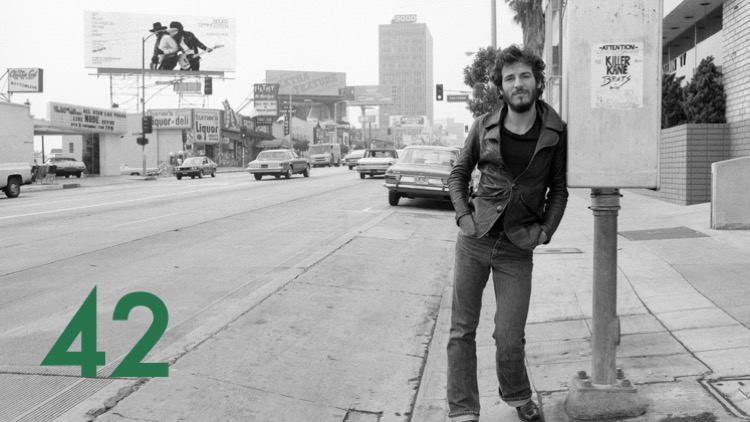

Bruce Springsteen was not an easy sell for me. Even looking at the attached video for “Born to Run,” I find myself reminded of the suspicion that I once held for his heartland, stadium bombast, hard-working, American iconography. It wasn’t until a friend virtually forced Nebraska on me that I allowed myself to begin to embrace Springsteen – and even then at arms-length.
But… This song. Holy shit. Back before what I always viewed as “cockiness” – again, watch the video below – came to define Springsteen, he was just another hungry singer-songwriter in search of a breakout. While something of a media darling from the outset of his career, that breakout wouldn’t truly come until the arrival of 1975’s Born to Run, and though that record was home to several of Springsteen’s greatest songs, it’s the title track that towers over everything else in his discography.
Dramatic to the max, “Born to Run” sounds intensely labored over, but it’s one of those rare rock tracks that is not rendered absurd by its epic ambitions. Using the teen drama themes and Wall of Sound production methods of Phil Spector, “Born to Run” was a thrilling meeting point between rock opera and pop single – its twinkling glockenspiel, revved-up saxophone solo, and lilting strings merely representing a small fraction of its notable instrumental embellishments.
Of course, Springsteen himself rules over the proceedings with a boastful romanticism that makes the earlier, uproarious “Thunder Road” (#140) seem positively quaint by comparison. It’s extremely tempting to take the cynic’s approach to “Born to Run,” but even as a long-time Springsteen skeptic, I can’t deny that – when heard in the right light – there are few rock songs more engaging and affecting than this one.
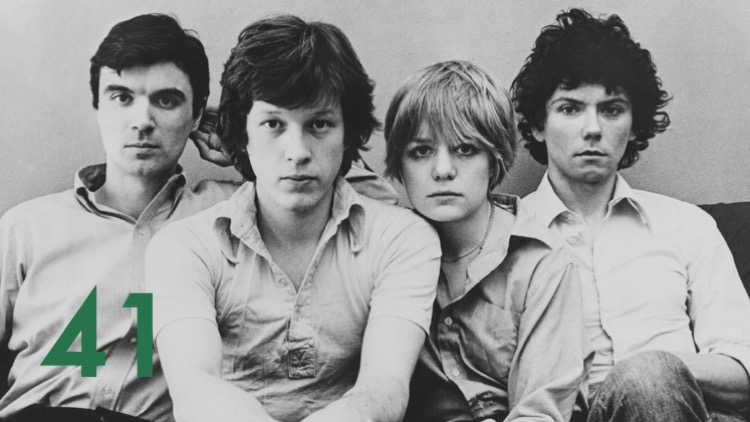

Who would have ever predicted than an existential crisis could be this damn catchy? The centerpiece to their masterful 1980 LP, Remain in Light, “Once in a Lifetime” is not only Talking Heads’ finest moment on record, but it is one of the most brilliant hit singles in the history of popular music.
By the time of the sessions for Remain in Light, Talking Heads had developed a remarkable rapport with Brian Eno, who had produced 1978’s More Songs About Buildings and Food and 1979’s Fear of Music. The perfect collaborator for this band of art school geeks, Eno pushed Talking Heads to indulge in their most experimental impulses, yielding thoroughly fascinating results on Fear of Music highlights, such as “I Zimbra” and “Life During Wartime” (#651). It was the post-punk/funk of the latter and the African-inspired polyrhythms of the former that would lead to “Once in a Lifetime.”
Taking inspiration from the work of Fela Kuti, “Once in a Lifetime” found Talking Heads crafting a heavy groove, and riding it out to a trance-like effect. Already established as the group’s not-so-secret weapons, bassist Tina Weymouth and drummer Chris Frantz’s fluid, hypnotic backing created an alluring backdrop on which frontman David Byrne could paint. Byrne’s lyrics sounded like nothing else on pop radio, then or now. Assuming the role of a television preacher delivering a heated sermon, Byrne’s interjections would become instantly quotable, and have remained so for over forty years since.
For all of the greatness of the song’s verses, it’s the chorus that elevates “Once in a Lifetime” to rarified air. Featuring the harmonized vocals of Byrne and Eno, the track’s circular refrain helped to set it apart from the other similarly great Remain in Light singles: “Crosseyed and Painless,” “The Great Curve,” and “Born Under Punches (The Heat Goes On)” (#500). Though it would take a few releases for the track to become a hit – also helped by its iconic video clip – it has long since become a staple of American radio.


